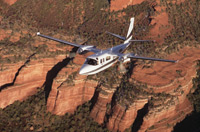Insurance Insight: Take Advantage
of Market Cycles


By Greg Reba
Anyone who’s ever owned an aircraft and needed insurance has experienced the aviation insurance marketplace and its quirks. Let’s do a quick review of how the system works. A handful of insurance companies issue aviation policies through their own employee underwriters, or contact underwriting managers to handle the business for them. Several others join in pools managed by an underwriting company. All of these underwriters work with independent brokerage companies to review submissions, quote accounts and, hopefully, earn your business. They also issue and service the policies and handle claims.
Aviation underwriting guidelines are sometimes confusing and frustrating. First, insurance companies will only offer terms in a quote no sooner than 60 to 120 days in advance of the expiration date of your current policy. For several reasons, they discourage “mid-term” marketing. The primary reasons are due to the extra work involved and overcoming early cancellation penalties found in the policy.
Another issue often mentioned by owners is getting competitive alternative quotes. Why can’t I call three brokers and get three quotes? The short answer is “First come, first served.”
Insurance underwriters will only accept one submission from their appointed broker. Many underwriters have multiple locations that work with many brokers in a geographical area. They track submissions using names and aircraft registration numbers. A quick computer check will show if they have received a request to quote. Later submissions will be “blocked” and not quoted. This business practice is used to reduce underwriter workloads and the embarrassment of quoting a different price through different offices.
ASK QUESTIONS
Truth be told, underwriters are human and subject to bias and/or different levels of experience. Aircraft owners need to shop for brokers who know the market and can best represent them. Go about it the same way you would select a doctor, accountant, or attorney: ask questions, get referrals, and check out their backgrounds.
Aviation insurance is a competitive business. The number of new aircraft entering the market every year is small, so insurance company growth is dependent on capturing a competitor’s market share. After the 9/11 terror attack we were down to seven major underwriting markets from a high of seventeen. The number of aviation insurers has doubled recently, but the aircraft fleet size has remained the same.
Why the change? Market cycles. After 9/11, investors retreated from the insurance market due to fear of more losses. The cost of reinsurance increased while availability decreased. This caused underwriters to raise rates and tighten underwriting standards. More aircraft were declined to be insured, and it became even more difficult to obtain higher liability limits. Stringent training and pilot standards were enforced. As a result, profits increased, investment capital and reinsurance returned, and new markets emerged looking for a slice of the profits.
Professionally flown turbine aircraft, having a low loss history, have become instant targets for aggressive pricing. Insurance premiums for pro flown aircraft have fallen by as much as 50 to 60 percent over the last few years. Owner-flown turbine aircraft have seen significant reductions in insurance premiums, better coverage, and higher liability limits. The good news for owner-pilots is that the gap between the premiums for an airplane flown by a hired professional pilot verses one flown by the owner-pilot has also decreased.
Before the change in market conditions, a negative generalization emerged about aircraft more than 25 years old. They were generally considered “out of production,” difficult and expensive to repair, and not maintained well. Fortunately, that is not the case today.
THE TWIN COMMANDER ADVANTAGE
Underwriters are constantly reevaluating the aircraft fleet, looking for profitable opportunities. This is true with everything from LSAs (light sport aircraft) to VLJs as well as the existing fleet. Important items to underwriters are training, product support, and loss history. Here’s where Twin Commander aircraft owners have an advantage. Excellent recurrent training is available from several sources. Product support and a strong service center network also ensure that if there is a claim, the resources are there to return the aircraft to service quickly and at reasonable cost. That isn’t always true with other aircraft, new or used. Underwriters need constant reminders and education on these items to assure that owners get the best rates available in the marketplace.
The current economic conditions and political bashing of general aviation have reduced the aircraft fleet, affected new deliveries, and lowered hull values of aircraft. When will the soft market end and the cycle reverse itself? Hard to predict, but underwriters are not optimistic of a change in the next 12 months. Recent attempts at “as expiring” terms from underwriters have been met by alternate quotes that are less than last year’s pricing.
After 24 years in the business and experiencing several market cycles, I’d like to offer some advice. Make sure your account is marketed this year and take advantage of what’s available. If you have been interested in higher liability limits, expanded territory, transitioning to a new aircraft, dry lease, or anything else, underwriters are willing to work with you to keep or gain a customer. Once concessions and coverage are granted it’s difficult for the underwriter to take these away when the market again turns hard.
Greg Reba is branch manager of NationAir Aviation Insurance’s Pittsburgh office. Headquartered in Chicago with offices at regional airports throughout the country. NationAir has specialized in brokering aviation insurance for more than 30 years.
Discuss this article in the forums...






